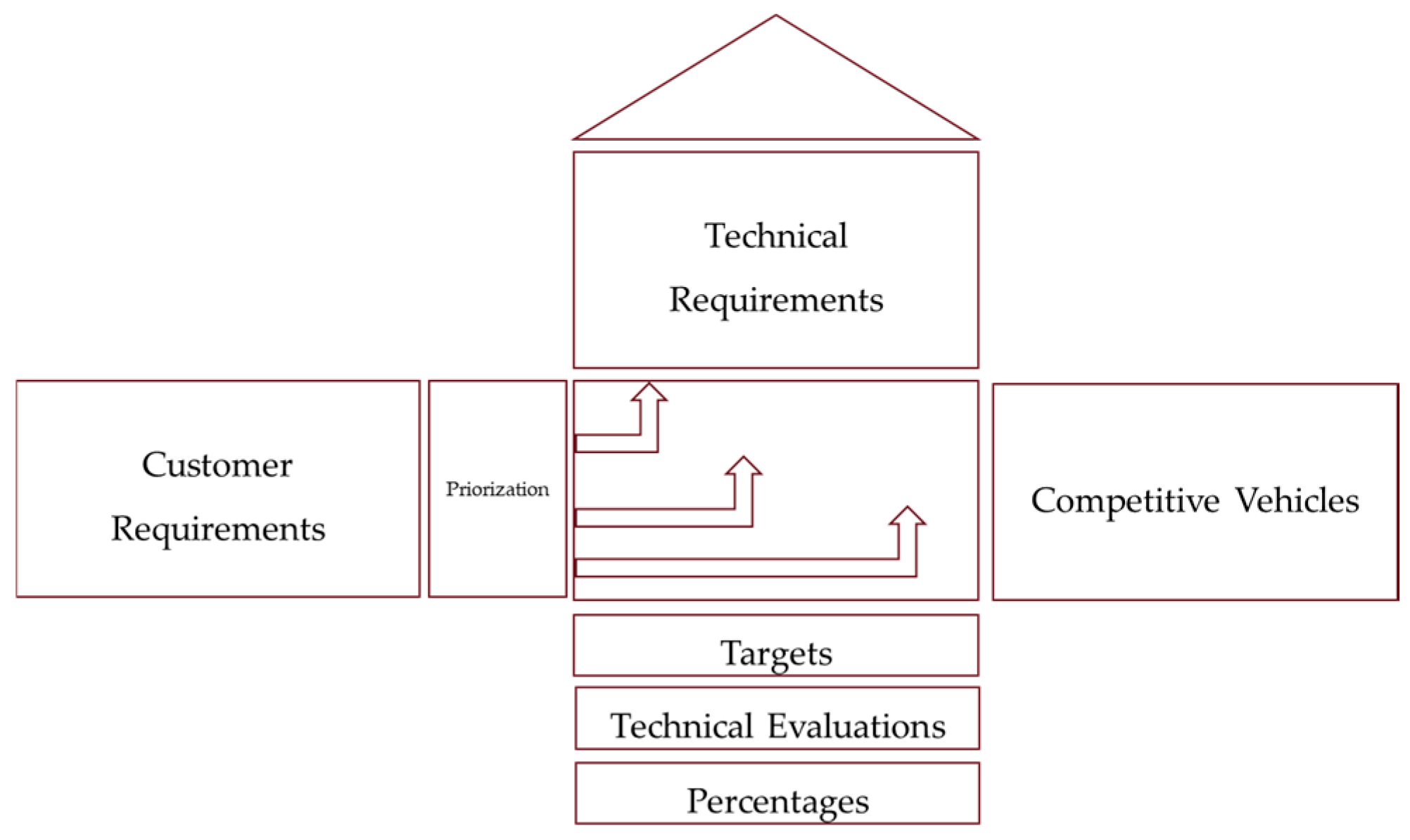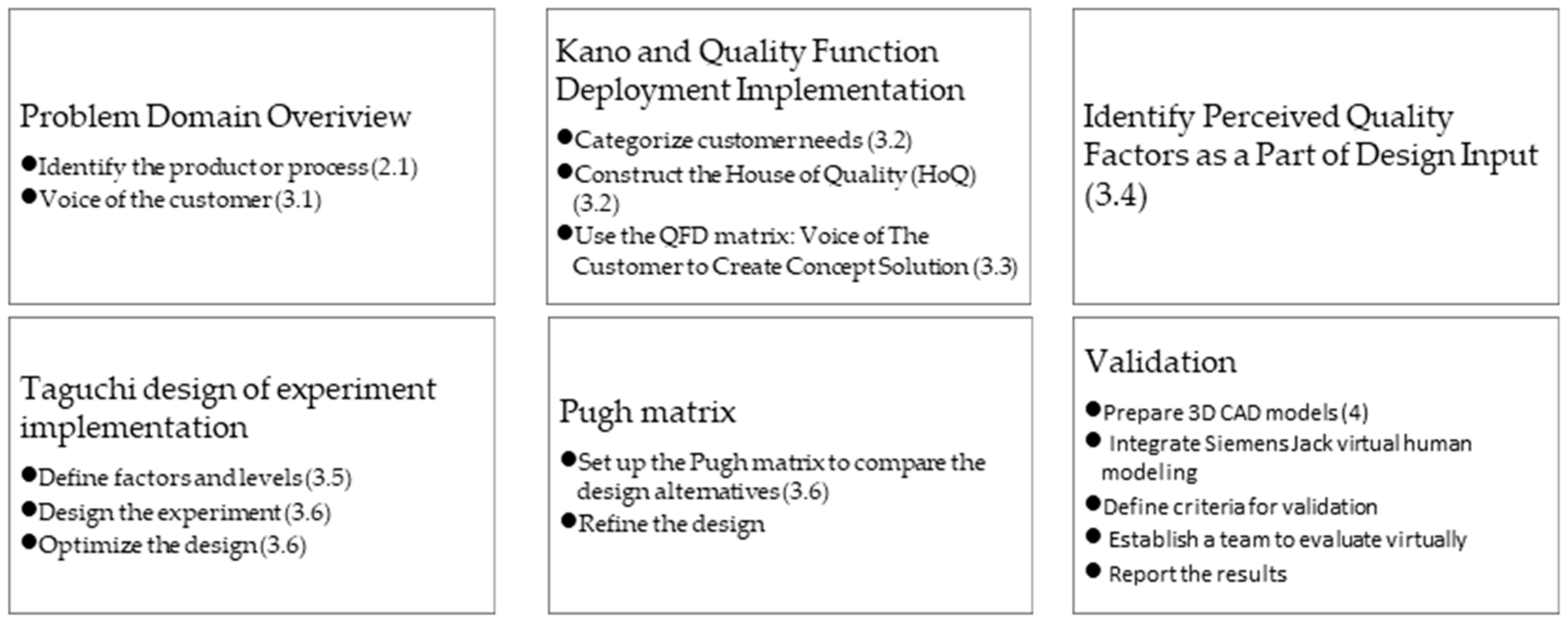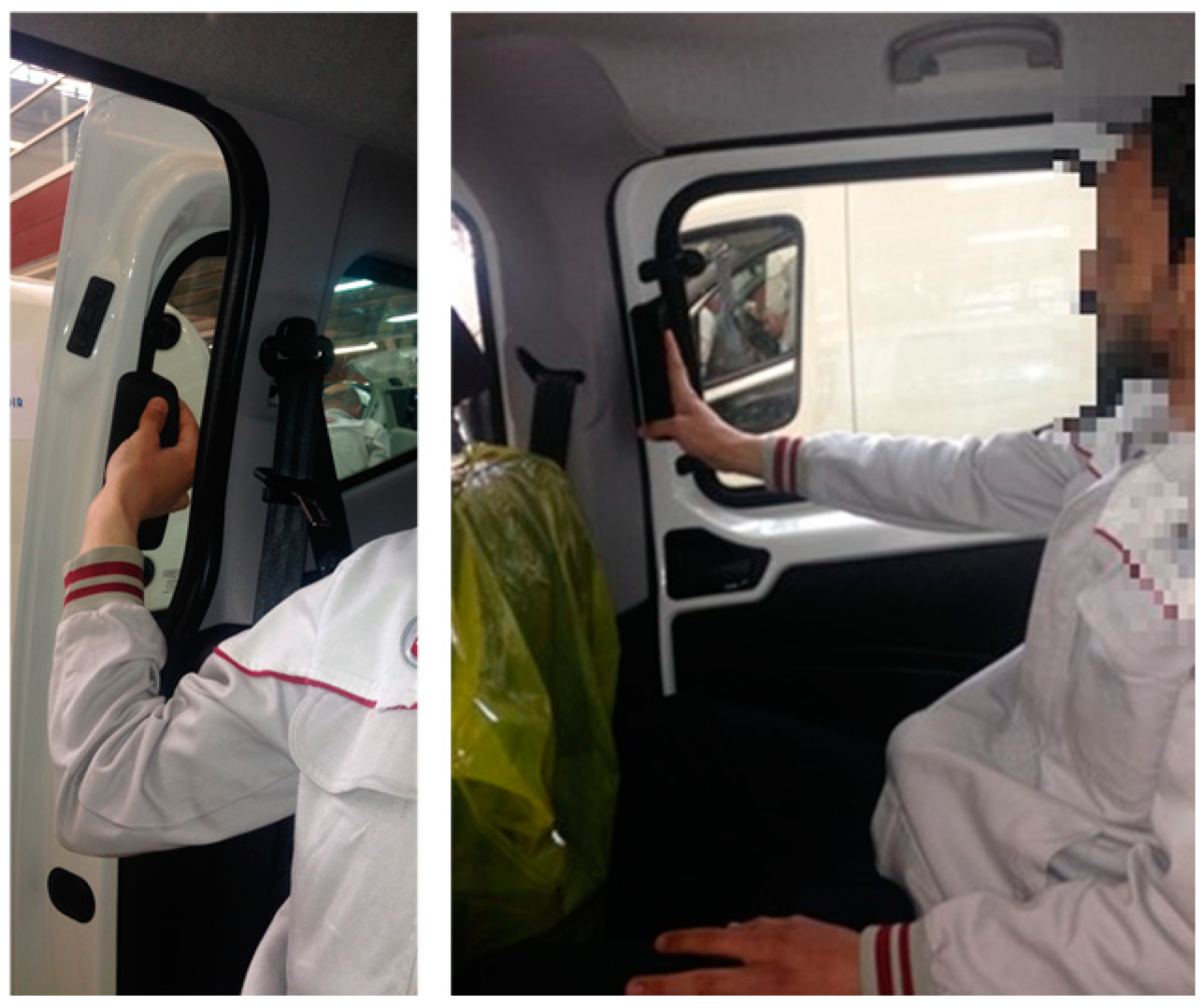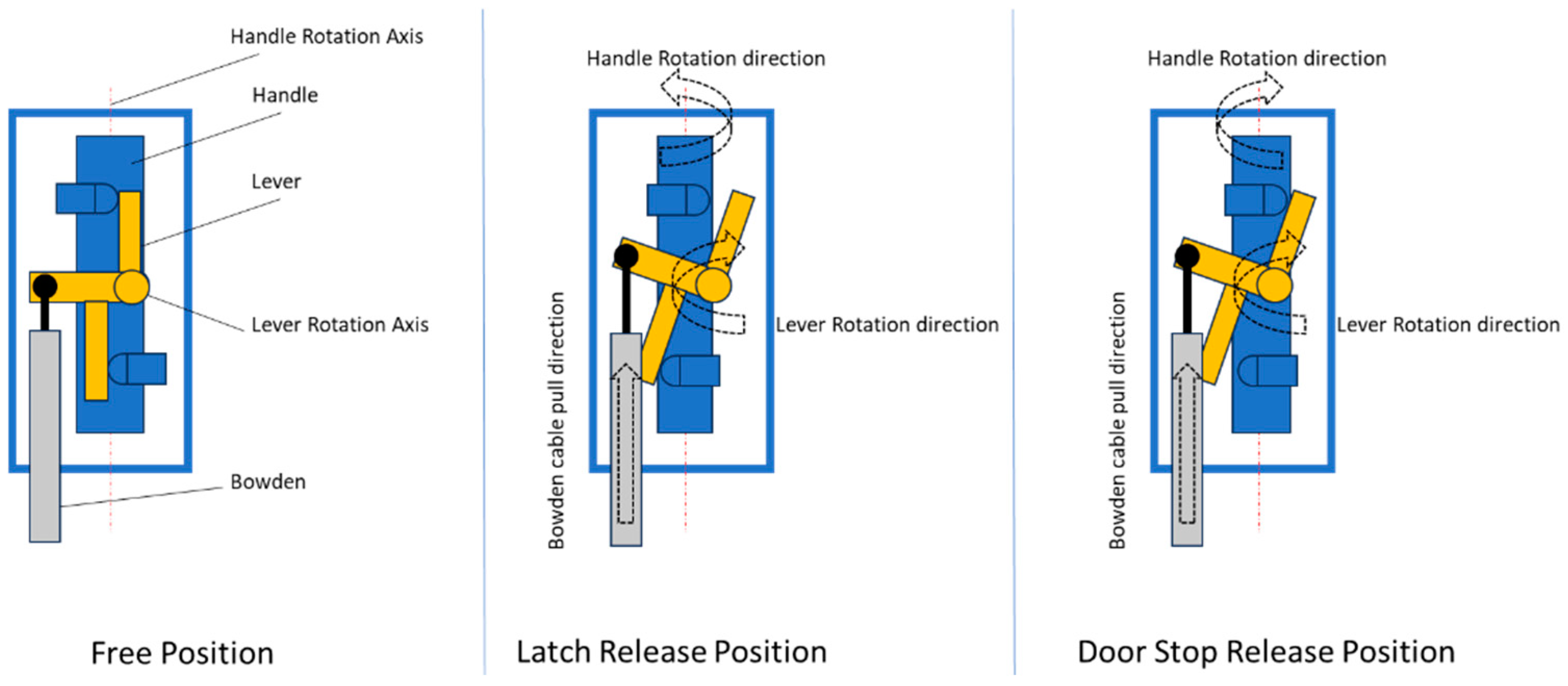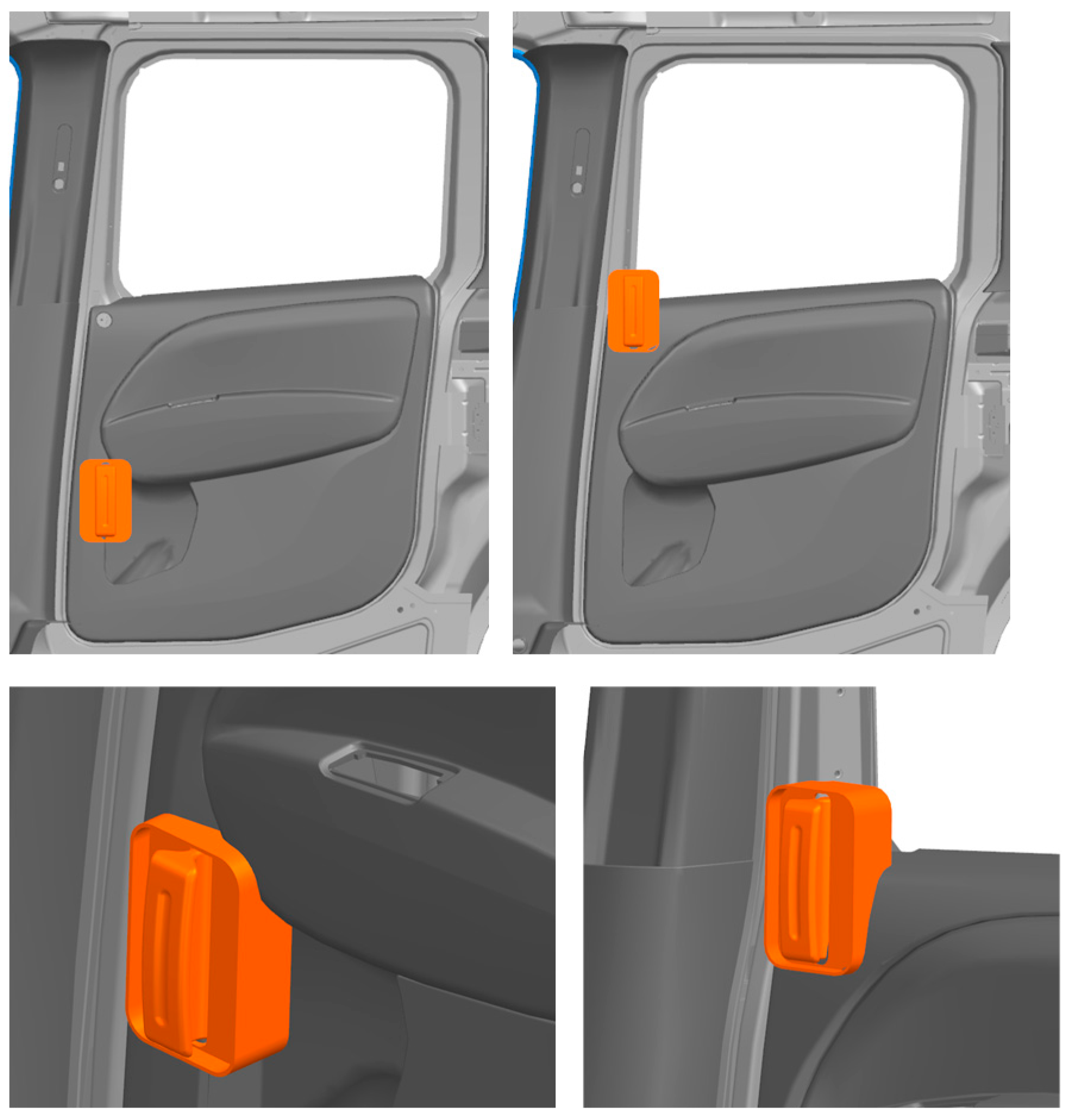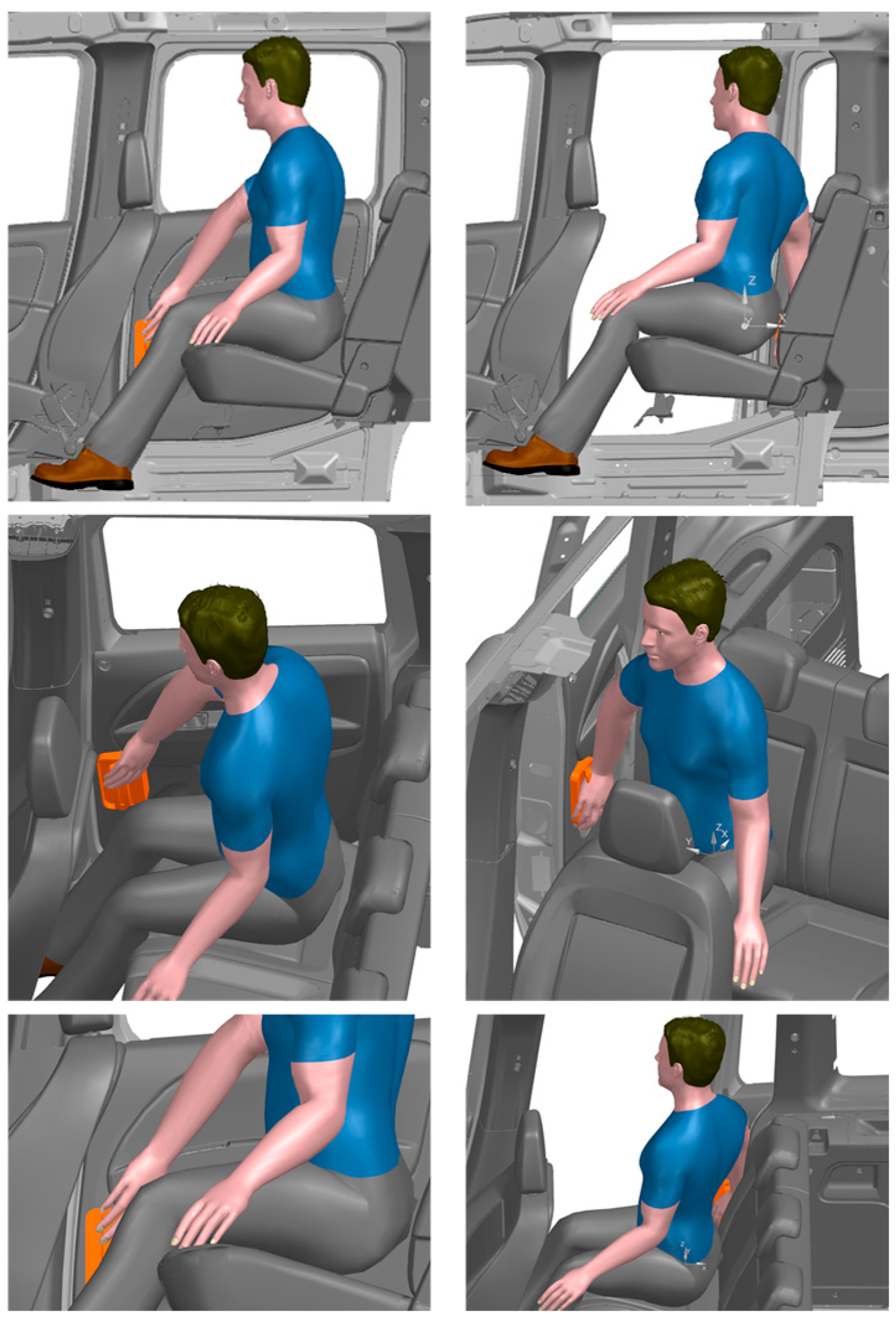1. Introduction
Delighting customers means exceeding their expectations. Customers can express their feelings about a product using basic words like “nice”, “wow”, or “awful”, but they cannot explain what their opinions in measurable engineering terms. As the opposites to customers, engineers can only improve metrics if they can measure them. The transformation from feelings to technical parameters is particularly challenging, especially in the automotive industry. The automotive world develops a wide range of customer needs with the help of engineering disciplines. Customer satisfaction consists of what we achieve through the five senses. Moreover, perceived quality has a sixth sense, and customers cannot even define why they perceive it positively or negatively. Understanding PQ is crucial for manufacturers and marketers in the highly competitive automotive industry, as it significantly influences consumer purchasing decisions and brand loyalty.
1.1. Perceived Quality
Quality comes from the Latin word qualis, its basic meaning is “of what kind”, and other meanings it carries include character, nature and essence. Garvin defines the eight dimensions of quality as performance, other characteristics that provide the product’s attractiveness, reliability, suitability, durability, service, esthetics, and PQ [
1]. PQ, as defined by Castleberry and McIntyre, is a “belief about the degree of excellence of a goods or service that is derived by examining consciously and/or unconsciously, relevant cues that are appropriate and available, and made within the context of prior experience, relative alternatives, evaluative criteria and/or expectations” [
2].
PQ is often distinguished from actual manufacturing quality, which is typically defined by adherence to specifications and technical standards. As noted by Stylidis et al., PQ involves customers’ cognitive and emotional responses to a vehicle’s design, which can be influenced by esthetics, brand reputation, and user experience [
3]. This distinction is essential because while manufacturing quality can be objectively measured, PQ is inherently subjective and varies among consumers based on personal preferences and experiences [
4]. Moreover, product quality differs from perceived quality, and human interactions with the product define it [
5]. PQ represents the customer’s assessment of a product’s quality based on visible and hidden cues when they have limited information about its specific quality attributes [
6].
PQ is a multi-approach concept that encompasses various aspects of a product, including its visual harmony, tactile sensations, and sound quality [
7]. Industrial design, ergonomics, and psychology are not fundamental branches of science, but the intersection of these fields and perceived quality cannot be ignored [
5]. Pogson (2020) [
8] focused on how consumers evaluate the PQ level of vehicles. Their research investigates visual harmony, like interior and exterior style or color matching of surfaces, which significantly influences consumer perceptions, evokes positive emotional reactions, and contributes to the overall perception [
8]. The design attributes of automobiles also significantly impact PQ. For instance, the study by Kato explores how exterior finishes, such as matte versus reflective surfaces, affect consumer perceptions of attractiveness and quality [
9]. His study aligns with the findings of Stylidis et al., who propose a framework for evaluating PQ attributes, suggesting that design elements are critical in shaping consumer perceptions and preferences [
10].
Bhise, V. D. (2011) [
11] describes interviews with many automotive users, main attributes of PQ are declared;
Visual quality (perfect fit of the parts; similarity between different surface and materials; invisible fasteners; reflection optimization to not distract users);
Touch/feel quality, pleasantness of surfaces;
Sound quality (pleasantness of noises and prevent annoying noises);
Harmony between materials, sizes of the parts, their finishes and smell quality.
1.2. QFD and Kano Models
QFD (Quality Function Deployment) is an impressive method of integrating design methods for the concept development of the parts [
12]. QFD gives an approach to convert customer requirements (CRs) to measurable and repeatable technical requirements (TRs) [
13]. QFD is a method for matching engineering design concerns and customer needs, including effective benchmarking. QFD is helpful for developing a design quality aimed at satisfying the consumer and then translating the consumer’s demands into design targets [
14]. QFD helps to increase overall quality, and it is part of the Total Quality Management (TQM).
The ISO standard 16355-1:2015 defines QFD as a method for systematically creating a correlation between the customer or stakeholders’ needs and technical inputs as a part of design process [
15]. In
Figure 1, the overview of the QFD table is shared.
Kano is a method of better understanding of CRs, and it sorts them in five categories; these include ‘excitement’, which refers to delight of the customer, ‘performance’ means customer are willing to have and ‘basic’ refers to must have needs, indifferent and reverse refers to having features that are contrary (
Figure 2) [
16]. Besides the traditional Kano model, new approaches are also suggested for the CRs classification. It is proposed to use eight satisfaction types of the Kano model, including less attractiveness and high attractiveness categories [
17].
The Kano model questionnaire asks about each specification with two questions, the first question is functional when the feature is present, and the second question is dysfunctional when the feature is absent. In the next step, the answers are evaluated and finally, each specification is categorized with respect to the Kano model [
15].
1.3. Taguchi Design of Experiment
The method developed by Dr. Genichi Taguchi demonstrates a systematic approach based on the experimental design for design optimization and quality control. The methodology suggests the use of orthogonal arrays, which allows for the efficient design of experiments by reducing the number of trials [
18].
1.4. Brief Explanation of Pugh Matrix
The Pugh matrix includes the evaluation of the strengths and weaknesses of the conceptual solutions created compared to the reference solution, thus selecting the best conceptual solution and creating hybrid solutions if necessary. This process is continued iteratively until the best solution is found [
19].
The ISO 16355-1:2021 [
15], “Application of statistical and related methods to new technology and product development process”, is a standard that provides guidelines in the context of product design, development, and improvement. Its main goal is to offer a systematic framework for using statistical tools to enhance the process and product design. The QFD, Kano, Taguchi experiment design, orthogonal array, and Pugh matrix are customer driven, robust design methods respect to this standard.
This study aims to use the PQ approach as an input for design specifications. Although other methods, such as QFD, Kano, Taguchi, and Pugh matrix, are referred to in the ISO 16355-1:2021 standard and are well-known in the literature, merging them with the PQ approach is a new topic. In this context, the current study explores a systematic approach to designing an automotive sliding door inner handle design and aligning design specifications with customer needs and perceived quality. This study targets the following issues: (1) translating customer feelings into technical parameters in a case study, (2) creating a sliding door inner handle concept design by implementing customer-driven and robust design methodologies and merging with the PQ approach. This integrated approach, grounded in the principles of customer relationship management, can enhance the design and delivery of products/services to better meet customer expectations [
20].
2. Methodology
The flow of the study is presented in
Figure 3. The team started the analysis by examining four vehicles with sliding doors. The inner handle features unlock the door and the handle positions differ. The Kano model is initially used to categorize the needs, which are then translated into technical requirements using the QFD method. The perceived quality approach is a design cue to increase customer satisfaction during the design phase. Instead of making many experiments for each parameter, the Taguchi method designs experiments. Finally, the Pugh matrix compares various design alternatives, selecting the one that best meets customer needs. Each method contributes to the framework by addressing different aspects of the design process, ensuring that the final solution is customer-centric and technically robust. The steps of this study are given in the flowchart in
Figure 3.
2.1. Problem Domain Overview
For the automotive industry, the appearance of a vehicle, particularly the execution of individual design elements, is an opportunity to differentiate from competitors and captivate customers [
7]. The inner handle of a sliding door is one such design element that can contribute to the overall perceived quality of the vehicle. This study investigates the integration of perceived quality activities to improve the design of the sliding door inner opening and closing system. The automotive body is a complex system that systematically links design specifications to customer needs and translates these requirements into a component design [
21]. OEMs present standard solutions for passenger car opening and closing door systems. Only material, shape, and coloring differences exist between them. On the other hand, there is no standard solution for the sliding door inner handles which are generally used for commercial vehicles. Passengers should unlock the door to open/close, slide, and put the door into locking position to keep it in the open/close state. The passengers need to reach out to the handle to open it. The door is in an open state, and the handle remains facing backwards to the passenger while closing. In addition, the passenger’s hand movement is limited as there is a small gap between the door and the vehicle’s body when the door is open (
Figure 4). Turning back slightly and accessing the handle is undesirable. When designing the sliding door opening system, automotive manufacturers must strike a delicate balance between functionality and esthetics, ensuring that the handle not only operates smoothly but also complements the overall perceived quality of the vehicle.
2.2. Implementation of the Methodology
The study’s main objective is to understand opinions and preferences from the customers’ point of view about sliding door inner handle design. This research aims to shed light on the design process. Four cars with sliding doors were selected to evaluate different styles during the subjective tests (
Figure 4). Brief details of the features and positions of door handles are shared in
Table 1. Sliding door designs and vehicle specifications have led to a diversification of handle types. Releasing the lock from a fully open/closed position, which can be performed with two sides, movable handles, buttons, passenger car type handles, or trigger, is given as feature 1 of the table. Sliding the door can be performed with the same handle, or in some vehicles, another handle is assembled, as briefed in feature 2. We can accept the bottom of the door glass as a line, the handles are mainly positioned on the upper side or aligned with this line, and these are given as feature 3 in the table. Twenty respondents are invited to understand the customer’s point of view. The team asked “for what purpose do you usually use your current vehicle” 35% is using for work, 35% for private, and 30% answered both. The distribution of gender, usage aim, and age are presented in
Figure 5. A face-to-face interview technique where respondents could physically experience product design is applied. Additionally, an in-depth interview technique is used to dive deep into various perceptions of the tested part.
3. Results
3.1. Voice of the Customer
In the process, interviewees get into the four vehicles, visually check them, and open/close the door and evaluate the ease of closing and opening, the handle reachability during opening/closing, posture to operate the handle, and the consequent hand/arm movement (
Figure 6). The first question is, “When you consider the door opening system and the ease of use, how much did you generally like the sliding door?”. Then, the customers’ expectations of the door opening system were collected and ranked between 1 and 5. The customer satisfaction score is calculated by dividing the total number of participants by those who gave 4 and 5 points, and the result is then multiplied by 100. In this scoring, evaluations above 80% are positive, evaluations between 60 and 80% indicate issues with potential for improvement, and ratings below 60% indicate customer dissatisfaction [
22]. The results are in
Table 2.
Based on our observations and verbal customer feedback, the expected aspects include the desired heavy/strong door feeling and ease of movement, and the sliding door fitting comfortably and confidently. The closing activity and its sound provide confidence. The sliding door needs to be easily used. This feedback is critical for PQ as it focuses on the customers’ first impressions.
3.2. Kano and Quality Function Deployment Implementation
The team used a questionnaire concerning the Kano method with the collaboration of 20 customers. The results showed that the customer needs for the inner handle can be quantified into excitement, performance, and basic categories according to the Kano Model in the QFD table. Many studies merge QFD and Kano studies [
23]. In this paper, Kano results are directly implemented to the QFD table (
Table 3) on the side of CRs, given as ‘B’ for basic, ‘E’ for excitement, and ‘P’ for performance needs. Then, CR rankings from 1 to 5 are added to the table. Concerning the QFD table structure, technical parameters affecting the design of the door opening system are written on the top line. The matrix is filled as 0, 3, 6, and 9, considering the strong relationship between each technical parameter and customer expectation. Competitive vehicles are evaluated in the last part of the table. Instead of using the brand names, they have been added to the table as vehicle A, vehicle B, vehicle C, and vehicle D. Customers rank each CR by evaluating competitive vehicles. In parallel with customer evaluations, technical parameters in competitor vehicles are taken, the matrix is calculated, and the values taken from the competitor vehicles are added to the target line determined at the bottom of the table.
3.3. Voice of the Customer to Create Concept Solution
By integrating the Kano model with QFD, the proposed framework can effectively prioritize design attributes and align them with customer needs while also considering the relative importance of these needs. The QFD table guides the team in converting non-technical CRs into technical parameters. CR “sensation of how to operate” is directly related to technical parameters like shape, grabbing properties, position, and clamp movement direction of the handle.
In addition, the QFD table’s bottom area shows us the prioritization of the technical values linked to CRs. The shape and grabbing properties of the handle relate to “design” and have scores of 415 and 409, respectively. The position of the handle had a score of 393. These scores lead us to the parameters to directly change. The strength required to open/close and the effort to open/close comes from the whole door system, like door weight, gravity center, and angle of the door rails and hinges, which are important technical parameters.
The team needs to check how each CR can be incorporated into designing the shape of the part. Regarding CRs, the ‘sensation of how to operate’ can only be provided by a simple design, and it can decrease geometrical variation. Additionally, other customer requirements, like fluid in motion, fast door movement, and ease of opening a door, can be achieved by a simple straight handle that transforms the force quickly into the system.
3.4. Identify Perceived Quality Factors as a Part of Design Input
One of the objectives of this research is to investigate PQ criteria as design input. Accordingly, the PQ approach and related design cues are in
Table 4.
PQ’s point of view suggests that designing a handle as a unique part is the best solution. The team designed the part with one handle, moving two sides for opening and closing. The handle needs to be fixed to the door, and all the screws and connections should be placed on the bottom surface due to concerns about invisibility.
3.5. Taguchi Design of Experiment Implementation
Sliding door opening and closing system parameters and levels are in presented
Table 5. The two factors and three-level experiment design are shared in
Table 6.
The team created a Taguchi orthogonal array design of nine combinations using Minitab 17 and shared it in
Table 7.
3.6. Pugh Matrix
The team makes comparisons in terms of customer demands between combinations created with orthogonal arrays. If the suggestion is more favorable than the reference system, it is shown with a ‘+’ sign, if it is negative, it is shown with a ‘-’ sign, and if it has no superiority over the other, it is shown with an S sign in
Table 7.
4. Discussion
Ensuring that the inner handle is well-designed and strategically positioned can significantly enhance the overall usability and accessibility of sliding doors, leading to increased user satisfaction and efficient door operation. The outcomes of our study reveal that a single handle, rotatable to both sides, is the output of the PQ approach (
Figure 7). The team designed crank movements to provide technical requirements aligned with the handle movement. The system uses a crank lever to rotate the handle movement with minimum effort.
The team created a virtual prototype of the proposed handle (
Figure 8). The same handle design is validated virtually in lower and upper positions, as they are crucial technical requirements due to the QFD table. The virtual validation is prepared using 3D CAD models, integrating Siemens Jack virtual human modeling, establishing a team to evaluate virtually, defining criteria for validation, and reporting the results. CAD models are prepared, and Siemens Jack virtual human modeling is performed (
Figure 9). This step helps assess how real users of different body types, postures, and movement capabilities interact with the product. Then, a jury of 10 individuals is invited to validate virtually according to the QFD table CRs list, and the customer’s posture is added to the validation criteria, and all are shared in
Table 8. The jury consists of automotive experts working on part design.
The jury discussed that the movement of the arm when opening and closing the door from a completely open position is uncomfortable; the handle position can only be reached by twisting the customer’s body backward and awkwardly bending the arm (
Figure 4). The maneuver becomes even more uncomfortable if three people sit on the rear seats, reducing the space to turn back and grab the handle. Furthermore, during the opening phase, it may be necessary to rotate the customer’s body further to avoid touching the door parts, such as seals with the elbow. The jury agreed to fix the door handle in the lower area of the sliding door to help with arm movement. The visibility of the handle is controversial: the handle is visible, but the hand and arm positions are not comfortable enough to open the door in the upper position of the handle. A standard solution in vehicles is to locate the sliding door handle on the upper side of the door. The jury evaluates the handle reachability and postures better during the opening in the upper position. However, the overall score for the opening is higher concerning the lower position (
Table 8). For closing the door, the rest of the eight scores of the usability criteria are higher than the lower position. The jury agreed that the lower position was preferable. Having a unique part for opening and closing the door and assembling it to the lower position of the door are the final decisions.
The design and positioning of sliding door inner handles is a crucial aspect of user experience and functionality, as they are the primary means of interacting with and operating these doors. This study suggests that a well-designed and strategically positioned sliding door handle can contribute to a heightened sense of perceived quality, thereby enhancing the user experience.
5. Conclusions
In summary, this research provides valuable insights into perceived quality activities that merge with the customer’s point of view with the help of a systematic approach to Kano and QFD methods. In the case of sliding doors, the inner handle is a critical touchpoint that can significantly influence a customer’s perception of the product. The sliding door inner handle of the vehicle is chosen to collect customer feedback, correlate it with technical parameters, evaluate benchmarks, and create a design. Our findings support the idea that perceived quality focus areas can be involved in product design. This study addresses a significant gap in our understanding of perceived quality as a design input by merging with QFD/Kano.
Beginning with VoC, all CRs are collected and evaluated using the Kano method, and the team started working on the QFD table. Our findings reveal that the design of a product from the conceptual phase begins with collecting CRs, and it is possible to convert them into technical parameters by seeing all inputs in the QFD table. Moreover, the research suggests that PQ criteria can be matched with CRs. Perceived quality reflects a customer’s first impression, and craftsmanship supports better-crafted parts by focusing on the fit of the part, robust design, and matching surfaces. This study bridges the gap between CRs, TRs, and PQ. The study aims to convert customer expectations to engineering parameters using methodologies and integrating the perceived quality point of view.
While this study focuses on a specific automotive component, the proposed approach can be generalized to various industries. The flexibility of this framework allows it to be adapted to any product design. Perceived quality is the first impression about a product; customer-driven methods could be merged systematically. Merging PQ methodology to concept design is a new approach based on established frameworks of Kano, QFD, Taguchi, and Pugh matrix. The connections of these methods establish customer-driven methodologies and extend current academic knowledge. This study can be used to build upon the framework established here to harmonize methodologies with a perceived quality approach for the optimization of product design from the beginning of a project.
Limitations
Some limitations are listed below, which have been highlighted for future studies. The study was based on 20 participants evaluating four vehicle models; although the team considered having a good balance between participants, the sample size could be improved in future studies. Many valuable studies define PQ, implement evaluations of products, and focus on customer interaction. Although PQ is a popular topic, implementing the voice of the customer and using it as a design input both methodologically and measurably has not yet been addressed in the literature. Future studies about statistical and customer-driven methodologies may be enlarged with the PQ point of view. Moreover, virtual prototypes are chosen but physical prototypes may be more useful for precise evaluations.
Author Contributions
Corresponding author, E.U.I.; conceptualization, E.U.I. and R.E.; methodology, E.U.I. and R.E.; investigation, E.U.I.; data curation, E.U.I., R.E. and K.S.; writing—original draft preparation, E.U.I.; writing—review and editing, E.U.I. and R.E. All authors have read and agreed to the published version of the manuscript.
Funding
This research received no external funding.
Institutional Review Board Statement
Ethical review and approval were waived for this study as it involved the administration of anonymous questionnaires that did not collect sensitive personal information. The study adhered to the ethical guidelines of Bursa Uludag University. Participants’ age, sex, profession, and years of experience were recorded for demographic analysis but were not linked to individual responses.
Informed Consent Statement
Informed consent was obtained from all subjects involved in the study.
Data Availability Statement
The original contributions presented in the study are included in the article, further inquiries can be directed to the corresponding author.
Acknowledgments
The authors would like to express their gratitude to TOFAS Turkish Automobile Factory A.S. and Bursa Uludag University for their support.
Conflicts of Interest
Authors Emel Unlukal Ilhan and Kenan Sert were employed by the company TOFAS Turkish Automobile Factory. The remaining authors declare that the research was conducted in the absence of any commercial or financial relationships that could be construed as a potential conflict of interest.
Abbreviations
The following abbreviations are used in this manuscript:
| PQ | Perceived Quality |
| QFD | Quality Function Deployment |
| VOC | Voice of customer |
| CR | Customer Requirement |
| TR | Technical Requirement |
| TQM | Total Quality Management |
References
- Garvin, D.A. Managing Quality: The Strategic and Competitive Edge; Simon and Schuster: New York, NY, USA, 1988. [Google Scholar]
- Castleberry, S.B.; McIntyre, F.S. Consumers’ quality evaluation process. J. Appl. Bus. Res. 1992, 8, 74–82. [Google Scholar] [CrossRef][Green Version]
- Stylidis, K. Perceived Quality of Cars. A Novel Framework and Evaluation Methodology. Ph.D. Thesis, Chalmers University of Technology, Gothenburg, Sweden, 2019. [Google Scholar]
- Yee, C.J.; San, N.C. Consumers’ perceived quality, perceived value and perceived risk towards purchase decision on automobile. Am. J. Econ. Bus. Adm. 2011, 3, 47–57. [Google Scholar]
- Jumisko-Pyykko, S.; Reiter, U.; Weigel, C. Produced quality is not perceived quality a qualitative approach to overall audiovisual quality. In Proceedings of the 2007 3DTV Conference, Kos, Greece, 7–9 May 2007; IEEE: New York, NY, USA, 1975; pp. 1–4. [Google Scholar]
- Solin, A.; Curry, A. Perceived quality: In search of a definition. TQM J. 2023, 35, 778–795. [Google Scholar] [CrossRef]
- Striegel, S.S. Perceived Quality in the Automotive: A Neural Network Based Assessment of Split-Lines; Technische Universitaet Berlin: Berlin, Germany, 2021. [Google Scholar]
- Pogson, I. The Assessment of Automotive Perceived Quality. Ph.D. Thesis, Coventry University, Coventry, UK, 2020. [Google Scholar]
- Kato, T. Perceived color quality: The effect of light reflection brightness of a car’s exterior design on consumers’ purchase intentions. Int. J. Eng. Bus. Manag. 2022, 14, 18479790221126791. [Google Scholar] [CrossRef]
- Stylidis, K.; Wickman, C.; Söderberg, R. Defining perceived quality in the automotive industry: An engineering approach. Procedia CIRP 2015, 36, 165–170. [Google Scholar] [CrossRef]
- Bhise, V.D. Ergonomics in the Automotive Design Process; CRC Press: Boca Raton, FL, USA, 2011. [Google Scholar]
- Frizziero, L.; Donnici, G.; Francia, D.; Liverani, A.; Caligiana, G.; Di Bucchianico, F. Innovative urban transportation means developed by integrating design methods. Machines 2018, 6, 60. [Google Scholar] [CrossRef]
- Chan, L.K.; Wu, M.L. Quality function deployment: A comprehensive review of its concepts and methods. Qual. Eng. 2002, 15, 23–35. [Google Scholar] [CrossRef]
- Altuntaş, S.; Dereli, T.; Özşalap, C. New product design for military aviation maintenance activities through quality function deployment (QFD). J. Fac. Eng. Archit. Gazi Univ. 2019, 34, 2187–2202. [Google Scholar]
- ISO 16355-1:2015; Application of Statistical and Related Methods to New Technology and Product Development Process. BSI Standards Publication: London, UK, 2015.
- Yadav, H.C.; Jain, R.; Singh, A.R.; Mishra, P.K. Aesthetical design of a car profile: A Kano model-based hybrid approach. Int. J. Adv. Manuf. Technol. 2013, 67, 2137–2155. [Google Scholar] [CrossRef]
- Yang, C.C. The refined Kano’s model and its application. Total Qual. Manag. Bus. Excell. 2015, 16, 1127–1137. [Google Scholar] [CrossRef]
- Khan, M.; Akhtar, R.; Babar, A. Optimization of high-pressure laminate manufacturing process by Taguchi method. Int. J. Adv. Eng. Res. Appl. 2021, 7, 47–57. [Google Scholar] [CrossRef]
- Guler, K.; Petrisor, D.M. A Pugh Matrix based product development model for increased small design team efficiency. Cogent Eng. 2021, 8, 1923383. [Google Scholar] [CrossRef]
- Shahin, A.; Nikneshan, P. Integration of CRM and QFD: A novel model for enhancing customer participation in design and delivery. TQM J. 2008, 20, 68–86. [Google Scholar] [CrossRef]
- Morello, L.; Rossini, L.R.; Pia, G.; Tonoli, A. The Automotive Body: Volume I: Components Design; Springer: Dordrecht, The Netherlands, 2011. [Google Scholar]
- Giró Manzano, P. Customer Satisfaction Measurement: Strategies, Methodologies and Factors Influencing Customer Satisfaction Measures. 2021. Available online: http://hdl.handle.net/10609/131866 (accessed on 10 January 2025).
- Chaudha, A.; Jain, R.; Singh, A.R.; Mishra, P.K. Integration of Kano’s Model into quality function deployment (QFD). Int. J. Adv. Manuf. Technol. 2011, 53, 689–698. [Google Scholar] [CrossRef]
| Disclaimer/Publisher’s Note: The statements, opinions and data contained in all publications are solely those of the individual author(s) and contributor(s) and not of MDPI and/or the editor(s). MDPI and/or the editor(s) disclaim responsibility for any injury to people or property resulting from any ideas, methods, instructions or products referred to in the content. |
© 2025 by the authors. Licensee MDPI, Basel, Switzerland. This article is an open access article distributed under the terms and conditions of the Creative Commons Attribution (CC BY) license (https://creativecommons.org/licenses/by/4.0/).
